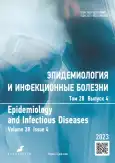Features of the profile of drug resistance to first-line and second-line anti-tuberculosis drugs in patients with human immunodeficiency virus infection
- Authors: Bulycheva E.V.1, Bulychev V.V.2, Velichko E.N.1, Pashkova N.A.2
-
Affiliations:
- Orenburg State Medical University
- Orenburg Regional Clinical Tuberculosis Dispensary
- Issue: Vol 28, No 4 (2023)
- Pages: 218-229
- Section: Original study articles
- Submitted: 22.05.2023
- Accepted: 22.06.2023
- Published: 08.09.2023
- URL: https://rjeid.com/1560-9529/article/view/448391
- DOI: https://doi.org/10.17816/EID448391
- ID: 448391
Cite item
Abstract
BACKGROUND: Drug resistance to anti-tuberculosis drugs directly affects the disease course. However, a high percentage of multidrug resistance in patients with HIV infection not only worsens the disease course but also forces the development of new strategies for managing such patients.
AIMS: To characterize drug resistance to anti-tuberculosis drugs in patients with HIV infection.
MATERIALS AND METHODS: The study recruited patients with newly diagnosed tuberculosis by molecular genetic research methods and bacterial research methods in the Orenburg Regional Clinical Tuberculosis Dispensary.
RESULTS: For 2018–2022, the proportion of people with HIV infection who are resistant to isoniazid by 14.6%, rifampicin by 28.85%, moxifloxacin by 717.39%, and amikacin by 104.25% has increased. The reduction in the choice of drugs and possibility of effective anti-tuberculosis therapy in people with HIV infection are also complicated by the detection of a multidrug-resistant culture in 20.34% of the examined patients and multidrug resistance in 39.6%. In over 5 years, the percentage of gene mutations of mycobacteria responsible for resistance to anti-tuberculosis drugs has increased.
CONCLUSIONS: The results of this study indicate the need to search for new solutions and prevent resistance to existing anti-tuberculosis drugs and for the development of new drugs effective for use as first- and second-line drugs.
Keywords
Full Text
About the authors
Ekaterina V. Bulycheva
Orenburg State Medical University
Author for correspondence.
Email: e-sosnina@mail.ru
ORCID iD: 0000-0002-8215-8674
SPIN-code: 8985-3210
MD, Cand. Sci. (Med.), Assistant Professor
Russian Federation, OrenburgVyacheslav V. Bulychev
Orenburg Regional Clinical Tuberculosis Dispensary
Email: vbolychev@yandex.ru
ORCID iD: 0000-0001-5963-4380
Russian Federation, Orenburg
Elena N. Velichko
Orenburg State Medical University
Email: lena.velichko.2012@mail.ru
ORCID iD: 0009-0005-5419-9574
Russian Federation, Orenburg
Nataya A. Pashkova
Orenburg Regional Clinical Tuberculosis Dispensary
Email: pashkova.dom@mail.ru
ORCID iD: 0000-0002-1735-357X
Russian Federation, Orenburg
References
- Gopalan N, Chandrasekaran P, Swaminathan S, Tripathy S. Current trends and intricacies in the management of HIV-associated pulmonary tuberculosis. AIDS Research and Therapy. 2016;13(1). doi: 10.1186/s12981-016-0118-7
- World Health Organization. Global tuberculosis report 2015. 20th ed. 2015. Available at: https://apps.who.int/iris/bitstream/handle/10665/191102/9789241565059_eng.pdf?sequence=1&isAllowed=y.
- Narendran G, Swaminathan S. TB-HIV co-infection: a catastrophic comradeship. Oral Dis. 2016;22 Suppl 1:46–52. doi: 10.1111/odi.12389
- Bonin CR, Fochat RC, Leite ICG., et al. Analysis of anti-tuberculosis drug resistance and sociodemographic and clinical aspects of patients admitted in a referral hospital. Einstein (Sao Paulo). 2019;18. doi: 10.31744/einstein_journal/2020AO4620
- Ignat’eva OA. Lekarstvennaya ustoichivost’ shtammov Mycobacterium tuberculosis i optimizatsiya diagnosticheskikh algoritmov na primere Samarskoi oblasti [dissertation]. Samara; 2015. (In Russ).
- Zhdanova SN, Ogarkov OB, Laz AA, et al. Investigations of mutations responsible for resistance to first and second line of TB drugs in Mycobacterium tuberculosis strains from the Irkutsk oblast and Sakha Republic (Yakutia). Sibirskii meditsinskii zhurnal. 2012;113(6):64–67. (In Russ).
- Savinova AA, Usanina LV. Mechanisms of antibiotic-resistance of mikobakterium tuberculosis. Mezhdunarodnyi studencheskii nauchnyi vestnik. 2017;(6). Available at: https://eduherald.ru/ru/article/view?id=17955 (In Russ).
- Kaplan JE, Benson C, Holmes KH, et al. Guidelines for prevention and treatment of opportunistic infections in HIV-infected adults and adolescents: recommendations from CDC, the National Institutes of Health, and the HIV Medicine Association of the Infectious Diseases Society of America. MMWR Recomm Rep. 2009;(58(RR-4)):1–207.
- Theron G, Peter J, Richardson M, et al. The diagnostic accuracy of the GenoType(®) MTBDRsl assay for the detection of resistance to second-line anti-tuberculosis drugs. Cochrane Database of Systematic Reviews. 2014;(10). doi: 10.1002/14651858.CD010705.pub2
- Akolo C, Adetifa I, Shepperd S, Volmink J. Treatment of latent tuberculosis infection in HIV infected persons. Cochrane Database Syst Rev. 2010;(1). doi: 10.1002/14651858.CD000171.pub
- Mitchison DA. Role of individual drugs in the chemotherapy of tuberculosis. Int J Tuberc Lung Dis. 2000;4(9):796–806.
- Recommendations for use of an isoniazid-rifapentine regimen with direct observation to treat latent Mycobacterium tuberculosis infection. Morb Mortal Wkly Rep. 2011;60(48):1650–1653.
- Sterling TR, Villarino ME, Borisov AS, et al. Three months of weekly rifapentine and isoniazid for latent tuberculosis infection. N Engl J Med. 2011;365(23):2155–2166. doi: 10.1056/NEJMoa1104875
- Balcells ME, Thomas SL, Godfrey-Faussett P, Grant AD. Isoniazid preventive therapy and risk for resistant tuberculosis. Emerg Infect Dis. 2006;12(5):744–751. doi: 10.3201/eid1205.050681
- Bulycheva EV, Bulychev VV, Pashkova NA. The problem of formation of new risks of medicinal resistance of patients with tuberculosis in condition of active use of antibiotics by population under COVID-19. Problems of Social Hygiene Public Health and History of Medicine. 2023;31(2):157–163. (In Russ). doi: 10.32687/0869-866X-2023-31-2-157-163
- Bulychev VV, Pashkova NA, Bulycheva EV. The problem of non-controlled use of antibacterial preparations by the population in the formation of drug resistance of mycobacteria during COVID-19 pandemic. Farmatsevticheskoe obrazovanie SamGMU. Istoriya, sovremennost’, perspektivy. Samara: Samara State Medical University; 2021. P. 173–178. (In Russ).
- World Health Organization. Guidelines for intensified tuberculosis case-finding and isoniazid preventive therapy for people living with HIV in resource-constrained settings. Geneva: World Health Organization; 2011. Available at: https://apps.who.int/iris/handle/10665/44472.
Supplementary files













